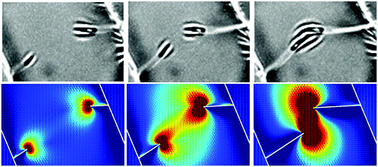The dynamics of interacting folds under biaxial compressive stresses†
Abstract
The gradual in-plane compression of a solid film bonded to a soft substrate can lead to surface wrinkling and even to the formation of a network of folds for sufficiently high strain. An understanding of how these folds initiate, propagate, and interact with each other is still lacking. In a previous study, we developed an experimental system to observe the wrinkle-to-fold transition of layered elastic materials under biaxial compressive stresses. Here we focus on the dynamic interaction of a pair of propagating folds under biaxial compression. We find experimentally that their behavior is mediated through their tips and depends on the separation of the tips and their angle of interception. When the angle is lower than 45°, the two folds either form a unique fold by the coalescence of their tips when close enough, or bend their trajectories to intersect each other and form a lenticular region in analogy with cracks. When the angle is higher then 45°, the folds simply intersect and form a T-like junction. We rationalize this behavior by conducting numerical simulations to visualize the stress field around the two tips and find that the initial geometric position of the tips primarily determines the final state of the folds.


 Please wait while we load your content...
Please wait while we load your content...